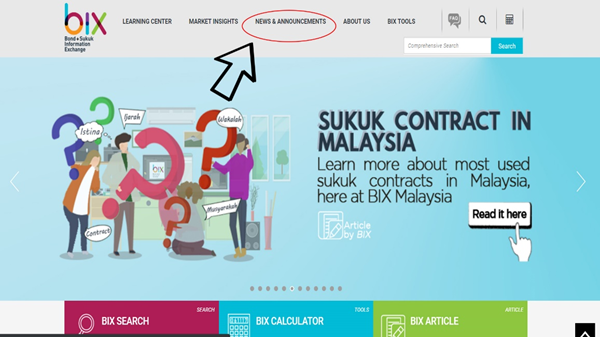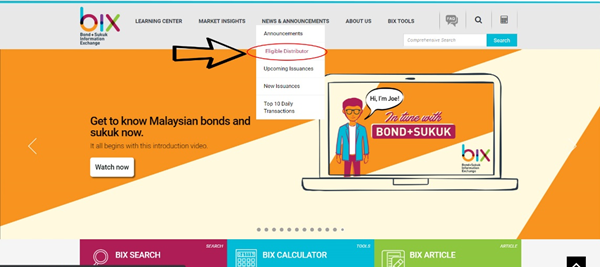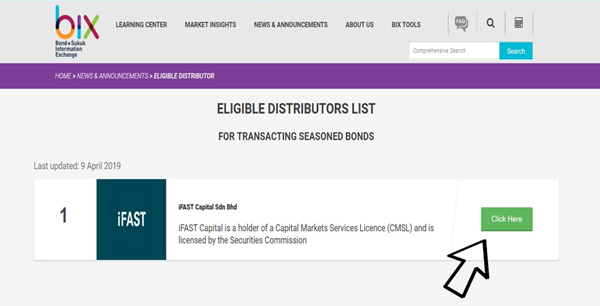
BIX ARTICLE
Investing in Bond Funds or Individual Bonds?
Oct 31, 2019
|
9 min read
Featured Posts
SRI Sukuk: The Journey Towards Sustainable and Responsible Investment
Jul 23, 2020
|
5 min read
Securities Commission's Capital Market Masterplan 3 (CMP3)
Sep 21, 2021
|
2 min read
What If We Allowed Retail Investors to Directly Invest in Malaysia’s Government Bond?
Aug 24, 2021
|
8 min read
Islamic Bonds Come Under Microscope After Garuda Indonesia Default
Aug 19, 2021
|
8 min read

Introduction
Before the Securities Commission liberalizes the bond and sukuk market framework in 2018, bond or sukuk market was inaccessible for retail investors in Malaysia as it required high cost of initial investment with the minimum amount of RM 250,000. Thus, many retail investors resorted to affordable bond funds as an alternative to investing in these asset classes. However, bond funds have a different mechanism from individual bonds in terms of the maturity date, principal return, income payment, and other characteristics. Due to these differences, it is important to be able to distinguish between bond funds and individual bonds before deciding which one to invest in.
Bond Fund
What is bond fund?
Bond fund is a mutual fund, but like the name sounds, it only invests in the bond asset class. Bond funds are typically sold by asset management institutions. When investing in a bond fund, the money deposited will be pooled together with the money from other investors. This pool of money then will be used to buy hundreds of bonds from many different issuers with various yields and maturities. This is why bond funds are preferred by some bond investors, as it offers diversification at a low cost compared to buying individual bonds. A professional fund manager will be assigned to manage the bond fund portfolio and decide which bonds to trade. Hence, investors only put money in the fund and leave the investment decisions to the fund manager.
One thing to note about the bond fund is, investors do not actually own the bonds, instead, they own shares or units of the bond funds. When investors put money in the bond fund, they actually buy the shares or units. The price of shares or units is subjected to Net Asset Value (NAV). The bond fund will calculate the NAV at the end of the day which determines the value of the bond fund. This means investors are open to fluctuation in bond fund values.
Individual Bond
What is individual bond?
Individual bond is a bond that investors buy from particular issuers or from other investors in the secondary market through intermediaries such as banks or brokers (Read more about bond here). Unlike bond funds, investors need to have a lot of investment capital in order to buy individual bonds. Typically, one lot of bond is sold for RM 5 million, while odd lots are sold for a minimum of RM 250,000. Imagine how much money investors need to prepare if they want to buy many lots of bonds just to buy their bond portfolios. This is the reason why bonds are invested only by high-net-worth individuals and institutional investors such as banks, asset management and insurance companies. Investors who invest in individual bonds own the bonds itself. Furthermore, issuers have contracted liabilities to bondholders according to the bond covenant (Read more about bond covenant here), and the investment capitals are guaranteed by the issuers.
Bond Fund vs Individual Bond
Ever since the Securities Commission has liberalized bond and sukuk framework, retail investors now have options to either invest in bonds via a bond fund or an individual bond as low as RM 1,000. As aforementioned, bond fund and individual bond are different in terms of maturity, income payment and principal protection which will be discussed in more details below:
Maturity
All bonds have a maturity date. The same issuer can issue multiple bonds at different maturities. Individual bond investors may hold the bonds until maturity and receive back their principals, or they also may choose to sell the bonds to other investors prior to maturity dates.
Bond funds comprised hundreds of bonds with different maturities. Hence, there is no exact maturity date in the bond fund as most bond funds are open-ended, which means, bonds are constantly bought and sold. When there are bonds mature in the fund, they will be replaced with new bonds. Some bonds can also be sold prior to their maturities if the fund managers think it is the right time to sell those bonds. Fund managers will buy or sell bonds according to what best in their opinions in order to keep up with the investment objectives. However, investors can still check the average maturity dates of all bonds in the bond fund with their respective fund managers.
Income Payment
For individual bond, investors will receive coupons or interest payments either annually or semi-annually. Most of the bonds in Malaysia are paid semi-annually which means investors get paid every 6 months. This coupon is fixed, and investors will keep receiving it as long as they hold on to the bond. In addition, investors who invest in individual bonds are certain about how much and when they will receive the income payment.

On the other hand, bond funds do not pay a fixed coupon as individual bonds do. Instead, investors will receive a fluctuating monthly income payment at the discretion of the fund. This income payment comes from coupons or proceeds from selling some bonds in the funds which collected together and distributed among investors. If there are many bonds in the fund give out coupons or their values appreciated when sold, then investors will receive higher income payment during the month. However, it still depends on the fund manager’s discretion either they want to distribute the income or not. Sometimes, fund managers want to reinvest the proceeds to buy new bonds which they think the new investment will give a better return in the future. Nonetheless, the value of the fund will be reflected in the NAV. If the fund makes more money, the NAV will increase, and investment value will go up.
Principal Protection
Individual bond investors will receive back the face value of the initial investment as guaranteed by the issuers when the bonds mature, provided the issuers do not default. If investors put RM 5,000 as their initial investment, and hold the bonds until maturity, they will still receive RM 5,000 back regardless of market condition. Compared to owning shares, bondholders have the priority when a company liquidates to pay back its debt. That is the advantage of investing in the individual bond.
Yet, it is not the same case as bond funds. As mentioned, bond funds do not have a maturity date. The only way investors can get their initial investments back is by selling shares or units they hold in the bond fund. Nevertheless, the amount of initial investment received could be the same, more or less depending on the NAV of the bond fund.
Net Asset Value is calculated by dividing the total value of all bonds in the fund with the number of outstanding units. For example, if the total value of bonds in the fund is RM 100 million, and there are 200 million units held by all investors, then the price or NAV would be RM 0.50 per unit. If investors first bought 500 units at RM 0.20 each (principal = RM100), then, when they sold the units, they would receive back RM 250 (500 units X RM 0.50).
Since bonds fund are actively traded by fund managers, the NAV changes based on the total value of bonds in the fund. If the total value of bonds is high, so does NAV, and vice-versa. This is why the money received from selling the units could be less or more than the initial investment.
Conclusion
Despite the differences between bond funds and individual bonds, both of them are great investment tools for investors. A bond fund offers investors an opportunity to diversify their bond portfolios at a low cost and a potential to gain high monthly income if NAV goes up. While an individual bond offers investors with fixed income and guaranteed principal protection when the bond matures. Either way, both of them are good avenues for investors to invest in bonds.
To answer the question of either investing in bond funds or individual bonds depends on investors’ preferences.
Investors can invest in bond funds if they prefer to have:
- Diverse bond portfolio at the minimum initial investment.
- Fluctuate income payments which sometimes could be high.
- An expert (fund managers) to manage the bond portfolio.
- Guaranteed principal by the issuer, provided issuer does not default.
- Fixed income through coupon payment.
- Rights as bondholders.
- On the Bix website homepage, click on the News and Announcement tab at the top.

- Click on the Eligible Distributor. This page will show all eligible distributors that can sell retail bonds.

- When all eligible distributors pop up, pick any and ‘Click Here’.

- It will then direct you to a website which listed all the bonds that you can buy as low as RM 1000.

This report has been prepared and issued by Bond and Sukuk Information Platform Sdn Bhd (“the Company”). The information provided in this report is of a general nature and has been prepared for information purposes only. It is not intended to constitute research or as advice for any investor. The information in this report is not and should not be construed or considered as an offer, recommendation or solicitation for investments. Investors are advised to make their own independent evaluation of the information contained in this report, consider their own individual investment objectives, financial situation and particular needs and should seek appropriate personalised financial advice from a qualified professional to suit individual circumstances and risk profile.
The information contained in this report is prepared from data believed to be correct and reliable at the time of issuance of this report. While every effort is made to ensure the information is up-to-date and correct, the Company does not make any guarantee, representation or warranty, express or implied, as to the adequacy, accuracy, completeness, reliability or fairness of any such information contained in this report and accordingly, neither the Company nor any of its affiliates nor its related persons shall not be liable in any manner whatsoever for any consequences (including but not limited to any direct, indirect or consequential losses, loss of profits and damages) of any reliance thereon or usage thereof.
YOU MAY ALSO LIKE
ARTICLE
Feb 05, 2025
|
4 min read
ARTICLE
Dec 02, 2024
|
4 min read
ARTICLE
Nov 01, 2024
|
4 min read
ARTICLE
Oct 08, 2024
|
7 min read



